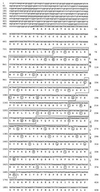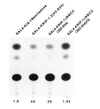A novel member of the RING finger family, KRIP-1, associates with the KRAB-A transcriptional repressor domain of zinc finger proteins
- PMID: 8986806
- PMCID: PMC26399
- DOI: 10.1073/pnas.93.26.15299
A novel member of the RING finger family, KRIP-1, associates with the KRAB-A transcriptional repressor domain of zinc finger proteins
Abstract
The Krüppel-associated box A (KRAB-A) domain is an evolutionarily conserved transcriptional repressor domain present in approximately one-third of zinc finger proteins of the Cys2-His2 type. Using the yeast two-hybrid system, we report the isolation of a cDNA encoding a novel murine protein, KRAB-A interacting protein 1 (KRIP-1) that physically interacts with the KRAB-A region. KRIP-1 is a member of the RBCC subfamily of the RING finger, or Cys3HisCys4, family of zinc binding proteins whose other members are known to play important roles in differentiation, oncogenesis, and signal transduction. The KRIP-1 protein has high homology to TIF1, a putative modulator of ligand-dependent activation function of nuclear receptors. A 3.5-kb mRNA for KRIP-1 is ubiquitously expressed among all adult mouse tissues studied. When a GAL4-KRIP-1 fusion protein is expressed in COS cells with a chloramphenicol acetyltransferase reporter construct with five GAL4 binding sites, there is dose-dependent repression of transcription. Thus, KRIP-1 interacts with the KRAB-A region of C2H2 zinc finger proteins and may mediate or modulate KRAB-A transcriptional repressor activity.
Figures








Similar articles
-
The Krüppel-associated box-A (KRAB-A) domain of zinc finger proteins mediates transcriptional repression.Proc Natl Acad Sci U S A. 1994 May 10;91(10):4514-8. doi: 10.1073/pnas.91.10.4514. Proc Natl Acad Sci U S A. 1994. PMID: 8183940 Free PMC article.
-
The KRAB domain of zinc finger gene ZNF268: a potential transcriptional repressor.IUBMB Life. 2003 Mar;55(3):127-31. doi: 10.1080/1521654031000110208. IUBMB Life. 2003. PMID: 12822888
-
Two novel Krüppel-associated box-containing zinc-finger proteins, KRAZ1 and KRAZ2, repress transcription through functional interaction with the corepressor KAP-1 (TIF1beta/KRIP-1).J Biol Chem. 1999 Jun 4;274(23):16412-22. doi: 10.1074/jbc.274.23.16412. J Biol Chem. 1999. PMID: 10347202
-
KRAB-containing zinc-finger repressor proteins.Genome Biol. 2003;4(10):231. doi: 10.1186/gb-2003-4-10-231. Epub 2003 Sep 23. Genome Biol. 2003. PMID: 14519192 Free PMC article. Review.
-
Evolution of KRAB-containing zinc finger proteins and their roles in species evolution.Yi Chuan. 2016 Nov 20;38(11):971-978. doi: 10.16288/j.yczz.16-056. Yi Chuan. 2016. PMID: 27867147 Review.
Cited by
-
CRISPR Activation/Interference Screen to Identify Genetic Networks in HDAC-Inhibitor-Resistant Cells.Methods Mol Biol. 2023;2589:429-454. doi: 10.1007/978-1-0716-2788-4_28. Methods Mol Biol. 2023. PMID: 36255641
-
A Novel CRISPR Interference Effector Enabling Functional Gene Characterization with Synthetic Guide RNAs.CRISPR J. 2022 Dec;5(6):769-786. doi: 10.1089/crispr.2022.0056. Epub 2022 Oct 17. CRISPR J. 2022. PMID: 36257604 Free PMC article.
-
Post-transcriptional regulation of cancer/testis antigen MAGEC2 expression by TRIM28 in tumor cells.BMC Cancer. 2018 Oct 11;18(1):971. doi: 10.1186/s12885-018-4844-1. BMC Cancer. 2018. PMID: 30309319 Free PMC article.
-
Evolution of C2H2-zinc finger genes and subfamilies in mammals: species-specific duplication and loss of clusters, genes and effector domains.BMC Evol Biol. 2008 Jun 18;8:176. doi: 10.1186/1471-2148-8-176. BMC Evol Biol. 2008. PMID: 18559114 Free PMC article.
-
Adenovirus E1B 55K represses p53 activation in vitro.J Virol. 1998 Apr;72(4):3146-54. doi: 10.1128/JVI.72.4.3146-3154.1998. J Virol. 1998. PMID: 9525640 Free PMC article.
References
-
- Klug A, Rhodes D. Trends Biochem Sci. 1987;12:464–469.
Publication types
MeSH terms
Substances
Associated data
- Actions
Grants and funding
LinkOut - more resources
Full Text Sources
Other Literature Sources
Molecular Biology Databases
Research Materials

